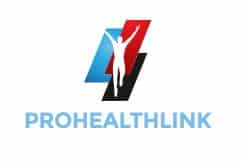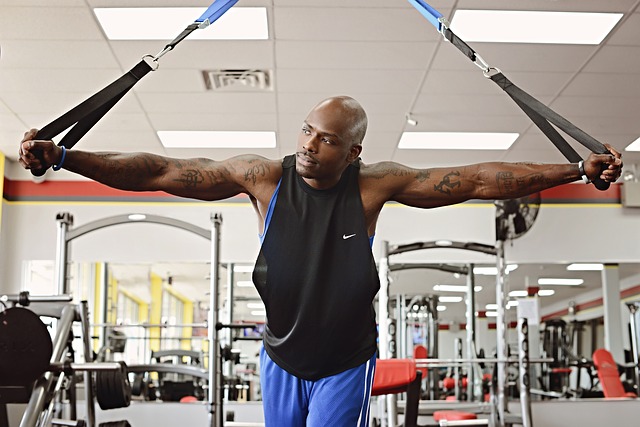Table of Contents
How To Lift Weights Properly As A Beginner
How To Lift Weights Properly As A Beginner – Are you trying to lose body fat or gain weight and increase your lean muscle mass? This resistance training program will be your definitive solution to a new, stronger and healthier you.
Sustaining a healthy lifestyle may be challenging and maintaining your fitness level is no walk in the park. We all know how busy life can get but it is crucial to devote time in that hectic schedule for exercise.
Activity Guidelines:
The Activity guideline states that in order to achieve health benefits, adults should accumulate a minimum of 150 minutes of moderate to vigorous physical activity per week.
On top of this, adults must incorporate muscle and bone strengthening exercises a minimum of 2-3 times per week in order to help reduce the risk of certain health conditions such as obesity, diabetes, high blood pressure, heart disease, stroke, etc (CSEP, 2018).
If you are looking to avoid weight gain, preventive maintenance is essential!!
1. Incorporate cardiovascular and weight training exercises into your daily routine
2. Select smart exercises and perform them consistently (Healthy lifestyle = consistent routine)
3. Give your body enough rest and recovery time

Classifications of Training:
In order to progress safely and effectively through a training program you first need to know where to start. The first step is to classify your training status as either beginner, intermediate or advanced (NSCA, 2015);
1. Beginners- People who currently workout 0-3 times per week and who have 0-6 months experience under a current training program.
2. Intermediate: People who currently work out 3-4 times per week and who have 8-12 months experience under a current training program.
3. Advanced: People who workout more than 4 times per week and who have over 1 year of experience under a current training program.
If your classification training status is at the beginning stages of working out and your main goal is to build muscle and enhance your bodies appearance, well look no further this program is designed just for you!!

Warm-up Benefits:
A proper dynamic warm-up is an integral part of any training session. It is designed to prepare the body for the demands of the upcoming workout and traditionally it has been thought of as a way to increase heart rate, increase blood flow to active muscles, improve muscular strength and power, while decreasing the risk of injury (NSCA, 2015).
A dynamic warm-up routine consists of 3 components:
Cardiovascular Activity:
Approximately 5-10 minutes of cardiovascular activity, starting at a low intensity and progressively building up to a light sweat (moderate intensity). Some examples of warm-up cardio can include biking, jogging, rowing, elliptical, etc.
Movement Preparation:
Approximately 5-10 minutes of movement prep. Each movement prep exercise should be performed for either 20-25 meters or for 5-10 repetitions. In this stage of warm-up it is important to move in different directions, such as forwards, backwards and laterally. Some exercises include side shuffle with arm swings, forward and backwards
skipping with arm swings, crossover steps, high knee march, high knee skip and high knee run, etc.

Dynamic Stretching:
Movement prep and dynamic stretching can be paired together so it will approximately take 5-10 minutes to complete. It is important keep the movement slow and controlled while safely moving through a full range of motion in order to prepare the
muscle for work. When preforming dynamic stretching movements it is important to start with general movements that mobilize joints that will be used in the upcoming workout or
those that need consistent work, such as our ankles, calves, hips and thoracic spine.
Below you will find some examples of effect and simple dynamic stretches:
| HAMSTRING STRETCH | 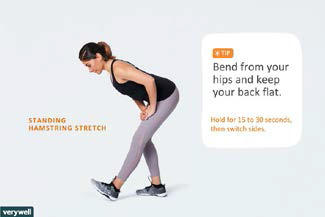 | Front heel down/toes up, front knee slightly bent • Weight through heel of back leg, knee behind toes • Sit back/push hips or butt back • Raise and lower body with back leg • Add arm movement (reach forward…) |
| CALF STRETCH | 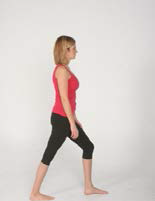 | Long step back, feet hip distance apart • Front knee slightly bent and toes visible in front of knee • Back leg – toes forward, heel on floor • Rise up onto back toe and lower down pressing heel into floor • Add arm movement (reach up…) |
| HIP FLEXOR STRETCH | 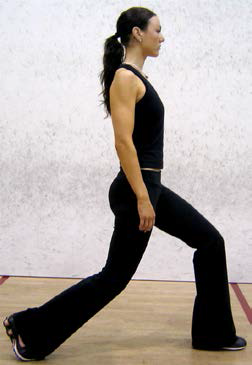 | Long step back, feet hip distance apart • Front knee slightly bent and toes visible in front of knee • Back leg – toes forward, heel on floor • Bend back knee and roll hip forward • Add arm movement (bicep curl, reach, chest press…) Adductor http://www. |
| ADDUCTOR STRETCH | 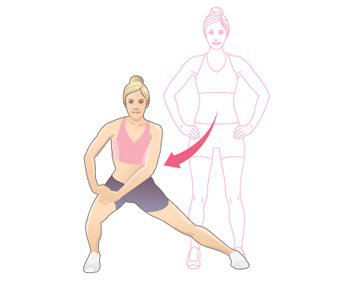 | • Feet wide apart, toes turned out slightly • Knees and toes in same direction • Hips back, weight through heels • Move side to side, knee does not go past toe • Add arm movement (reach side…) |
| THEORACIC STRETCH | 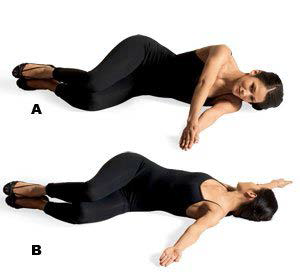 | • Reach with the top arm • Bring that arm towards the floor • Follow the arm with your eyes to initiate rotation from your upper back |
What are Repetitions (Reps) and Sets:
A repetition is one complete movement of any exercise, while a set means performing a group of consecutive repetitions. For example if someone says to you that they did “2 sets of 10 reps of squats”, that means that they performed 10 consecutive squats, rested and then performed another 10 squats.
Resistance Training Program:
For those whose training status is classified as beginner the recommended frequency of training is 2 to 3 times per week. In this 4-week beginners program we have developed a 3 day per week resistance training routine that targets your chest, back, shoulders, biceps and triceps muscles, along with your entire lower body.

Let’s get started!
Weeks 1 and 2: (Phase One)
The first 2 weeks are going to focus on hypertrophy and muscular strength components of fitness. Muscular hypertrophy means increasing muscle size while muscular strength represents the maximal amount of force that can be generated by the muscle or group of muscles.
This phase of the program consists of 3 full body workouts to be performed on alternating days. When doing full body workouts it is important to give yourself between 24-48 hours rest before repeating exercises that work the same muscle group.
Whenever the body experiences new or more intense stress than previously applied, your body’s initial response is an accumulation of fatigue, soreness or stiffness. This can last for several hours or even days. Once your body has experienced this initial response, it adapts to the stimulus and returns to a normal functional capacity.
If you were to do the same exercise everyday your body wouldn’t be able to adapt to the changes thus increasing the likelihood of injury. Therefore I recommend giving your body a minimum of 24 hours before performing another full body workout and you will see this outlined throughout this resistance program.
You are to complete 3 sets of 10-12 repetitions of each exercise. Between each set give yourself 45 seconds of rest. Note: If you are working out with a partner I recommend that one partner perform the exercise with the other partner rests or spots. Upon completion of the desired repetitions, you and your partner switch roles.
Monday: Total Body Workout:
Tuesday: Rest & Recovery Day
Wednesday: Total Body Workout
Thursday: Rest & Recovery Day
Friday: Total Body Workout
Saturday: Rest & Recovery
Sunday: Rest & Recovery
All of the main movements that are stated in this program focus on compound activities while having a secondary focus on isolation movements. Each week the intensity varies and the amount of rest between sets for each activity is optimal for building muscle.
The volume load for each muscle group per exercise is based on the recommended volume range for beginners. The greater part of the segments that work best to build muscle has been gathered in one perfect exercise outline.
Muscle Building Exercises:
When lifting weights it is important to use similar weights each set for every exercise. You would use a similar weight on each of the 3 sets, in the event that it says to complete 3 sets.
Week 3 and 4: (Phase 2)
This phase of the program is a progression of the first two weeks. We are going to shift our workouts from full body to split upper body and lower body routines. Instead of completing 3 sets like you did in phase one, we are going to increase the number of sets to 4 while still focusing on muscular hypertrophy and muscular strength (10-12 repetitions).
Monday: Lower Body Workout
Tuesday: Rest & Recovery Day
Wednesday: Upper Body Workout
Saturday: Rest & Recovery
Sunday: Rest & Recovery
Timing Load Increases:
How do you know when it is time to up your training load? I recommend following the 2-for-2 rule.
 This rule states that if a person can perform two or more repetitions over their assigned repetition goal for a given exercise in the last set in two consecutive workouts, weight should be added to that exercise during the next training session.
This rule states that if a person can perform two or more repetitions over their assigned repetition goal for a given exercise in the last set in two consecutive workouts, weight should be added to that exercise during the next training session.
I’m sure that your next question is going to be, well how much weight do I add? According to the National Strength and Conditioning Association (Essentials of Strength Training and Conditions, 2015, p. 460) increasing load increments are as follows:
Description of Individual:
Body Area Exercise
Estimated Load Increase
Smaller, weaker, less trained
Upper Body
2.5-5lbs
Lower Body
5-10lbs
Larger, stronger, more trained
Upper Body
5-10+lbs
Lower Body
10-15+lbs
In conclusion this program is designed for beginners and should be followed as you see fit from the above program.
Although the exercises have not changed much between Phase 1 and 2, we have adjusted the Fitness components (frequency, intensity, time and type).
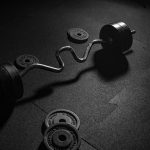
Most resistance training programs or phases of programs are designed to range between 4 to 6 weeks in duration.
This amount of time allows the body to progress through different movements without adjusting or becoming immune to any longer of a program.
Any program that lasts longer than 6 weeks increases your chances of developing a plateau. If you notice yourself plateauing this is a clear sign that you have to switch up your training program.
Within 4 weeks you can change the variables within the program but your exercises are still the same, you can change things such as the weight used and time under tension, how many sets and how many reps you do but the overall exercises don’t change within 4 weeks.
References:
Haff, G., & Triplett, N. T. (2016). Essentials of strength training and conditioning (4th ed.). Champaign, IL: Human Kinetics.
Adjustable to incline, flat and decline chest press positions Price: $161.11 Olympic bench for working chest, shoulders, biceps, legs, and more Price: $378.22 Deep angled rear base allows for better squat and bench positioning Price: $229.99 Dimensions: 80"H x 63"D x 64"W (distance between bar holders is 48") Price: $699.99 Transform any space into a personal free weight fitness center Price: $503.99CAP Barbell Standard Bench Black/red
Accomodates most standard barbell sets with a 5-feet to 6-feet bar
Leg lift is designed to target hamstrings, quadriceps and glute musclesMarcy Olympic Weight Bench for Full-Body Workout
Adjustable seat and back pad with slide track for proper posture
Adjustable preacher curl pad and bar; reverse walk-in squat stationAmStaff Fitness Multi Functional Squat Rack, Bench Press Barbell Rack Stand with Weight Plate Storage Attachment…
8-Inch Long safeties/spotters
Bar and Weight Plates are not includedAmStaff Fitness SD1050 Multi Squat Rack
2.5" x 2.5" mainframe and 2" x 2" safeties
Strength Bands, Olympic Bar and weights are not included.Bowflex Weight Bench Series
Adjusts to four different positions for over 30 different exercises
Comes with a removable leg hold-down brace for added decline position support
